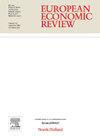Institutional diversity and innovative recombination
IF 2.8
2区 经济学
Q1 ECONOMICS
引用次数: 0
Abstract
In Explaining Technology, Koppl et al. (2023) argue that “recombination is the essential driver of technological evolution” (p. 3). Modelling combinatorial innovation as a self-propelling, “autocatalytic” process raises the question of what explanatory role, if any, is left for institutional analysis. Although the authors grant institutions only an auxiliary explanatory role, they hint at the functional importance of market institutions, trade networks, patent law, and entrepreneurship. Our paper argues that institutions matter because they crucially affect aggregate levels and rates of recombination and innovation, as well as shaping patterns of recombination and innovation that occur. This paper builds upon Koppl et al.’s acknowledgement of these institutional effects by integrating combinatorial evolution within recent developments in commons theory and institutional economics. Specifically, we argue the burgeoning literature on Governing Knowledge Commons offers a fruitful framework and body of empirical case studies that illuminates the diverse institutions individuals use to facilitate and steer combinatorial innovation. Whilst healthy institutional diversity may incentivize more recombination than any single monocentric institutional arrangement, the non-teleological aspect of recombination means that innovative processes can exude either productive, unproductive, or destructive effects. The institutional diversity fostered by flourishing knowledge commons may allow people to put combinatorial innovations into more productive uses while internalizing their complex externalities. At the same time, it may generate socio-cultural resistances to some forms of innovation processes. We illustrate our theory using cases related to several applied topics including intellectual property, competition policy, and the development of unmanned aerial vehicles.
制度多元化和创新重组
在《解释技术》一书中,Koppl等人(2023)认为“重组是技术进化的基本驱动力”(第3页)。将组合创新建模为一个自我推进的“自催化”过程,提出了一个问题,即如果有的话,留给制度分析的解释作用是什么。虽然作者认为制度只是一个辅助的解释作用,但他们暗示了市场制度、贸易网络、专利法和企业家精神的功能重要性。我们的论文认为,制度之所以重要,是因为它们对重组和创新的总体水平和速度产生了至关重要的影响,并塑造了重组和创新的模式。本文建立在Koppl等人对这些制度效应的承认的基础上,通过将组合进化整合到公地理论和制度经济学的最新发展中。具体来说,我们认为新兴的关于管理知识共享的文献提供了一个富有成效的框架和实证案例研究体,阐明了个人用来促进和引导组合创新的不同制度。虽然健康的制度多样性可能比任何单一的单中心制度安排更能激励重组,但重组的非目的性方面意味着创新过程可能产生生产性、非生产性或破坏性的影响。蓬勃发展的知识共享所促进的制度多样性,可能使人们在内化其复杂的外部性的同时,将组合创新投入更有成效的用途。与此同时,它可能会对某些形式的创新过程产生社会文化阻力。我们使用与几个应用主题相关的案例来说明我们的理论,包括知识产权、竞争政策和无人驾驶飞行器的发展。
本文章由计算机程序翻译,如有差异,请以英文原文为准。
求助全文
约1分钟内获得全文
求助全文
来源期刊

European Economic Review
ECONOMICS-
CiteScore
4.70
自引率
3.60%
发文量
170
期刊介绍:
The European Economic Review (EER) started publishing in 1969 as the first research journal specifically aiming to contribute to the development and application of economics as a science in Europe. As a broad-based professional and international journal, the EER welcomes submissions of applied and theoretical research papers in all fields of economics. The aim of the EER is to contribute to the development of the science of economics and its applications, as well as to improve communication between academic researchers, teachers and policy makers across the European continent and beyond.
 求助内容:
求助内容: 应助结果提醒方式:
应助结果提醒方式:


